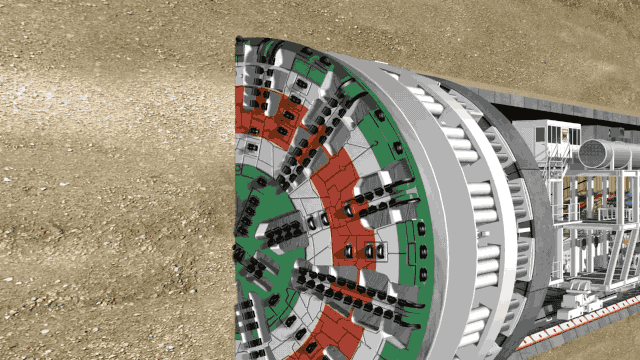What are the four main components of a TBM (Tunnel Boring Machine)? A TBM is the core equipment for tunnel construction, and its efficient operation relies on the coordinated operation of multiple key systems. The four core components (systems) of a TBM are generally considered to be the cutterhead, shield system, propulsion system, and mucking system. These systems are responsible for rock breaking, protection, propulsion, and mucking removal, respectively. They are described below:

1. Cutterhead
The cutterhead is the component of the TBM that directly contacts the tunnel face (excavation working face). Its core function is to break up rock or strata to create space for tunnel excavation.
① Structure: Typically circular (matching the tunnel cross-section), the cutterhead is welded from high-strength steel. Multiple cutter mounting holes are located on the cutterhead surface, allowing different types of cutters (such as roller cutters, scrapers, and cutters) to be installed depending on the geological conditions. Some cutterheads have openings (mud holes) for the crushed mucking to enter the cutterhead.
② Working Principle: Driven by a main drive system (electric or hydraulic motor), the cutterhead breaks the ground through the compression and shearing action between the cutterhead and the rock. For example, a hard rock TBM primarily relies on disc cutters to crush the rock, creating cracks and fragmenting it; a soft soil shield (a type of TBM) uses scrapers to cut the soil.
③ Key Function: Directly determines tunneling efficiency and cutter wear. Its design must match the hardness and integrity of the ground (e.g., hard rock cutterheads require higher strength, while soft soil cutterheads must be resistant to clogging).
2. Shield System
The shield system is the "protective shell" of the TBM. Its primary function is to support the tunnel face and the excavated tunnel section, preventing surrounding rock collapse and soil and water intrusion. It also provides a mounting platform for internal equipment (such as thrust cylinders and segment assembly machines).
① Structure: The shield varies depending on the TBM type (open or shielded). Shield-type TBMs (such as earth pressure balance shields and slurry shields) typically have a front shield (located near the cutterhead, protecting the main drive), a middle shield (mounted with propulsion cylinders), and a tail shield (enclosing the segment assembly area, with seals between the segments to prevent leakage). Open TBMs have simpler shields, primarily used for local support.
② Key Function: Ensures tunneling face stability and construction safety, serving as a core protective component, especially in soft soil and water-rich formations.
3. Propulsion System
The propulsion system is the "driving force" of the TBM. Its core function is to provide axial thrust and torque, propelling the cutterhead toward the tunnel face and advancing, while also controlling the tunneling direction (attitude).
① Structure: Primarily composed of multiple sets of hydraulic cylinders (thrust cylinders), one end of which is connected to the center shield (or frame) and the other end rests on the assembled segments (or surrounding rock). Thrust is generated by the extension and retraction of the cylinders. Some systems also include guide mechanisms (such as tilt cylinders) to adjust the TBM's pitch and yaw angles, thereby controlling the tunneling trajectory.
② Working Principle: The system utilizes the reaction force of the segments (or surrounding rock) to transmit thrust to the cutterhead, forcing the cutters into the rock and breaking the formation as the cutterhead rotates. The thrust is dynamically adjusted based on the hardness of the formation (harder rock requires greater thrust).
③ Key Function: It directly determines tunneling speed and directional accuracy and is a core system for ensuring that tunnel linearity meets design requirements.
4. Mucking System
The mucking system is the TBM's "clearance channel." Its core function is to continuously transport the mucking (rock debris and soil) crushed by the cutterhead from the tunnel face to the outside of the tunnel, preventing accumulation that could hinder tunneling.
① Structure: These vary significantly depending on the TBM type:
a. Hard Rock TBM: Typically, a "scraper conveyor + belt conveyor" combination is used. Muck at the tunnel face falls through the cutterhead opening into the machine's internal hopper, where it is transferred by the scraper conveyor to the belt conveyor. The belt conveyor then transports the sack to the tunnel entrance.
b. Soft Soil Shield (such as an Earth Pressure Balance Shield): A screw conveyor is used. Muck passes through the cutterhead opening into a sealed chamber, where it is discharged by a rotating screw conveyor onto the belt conveyor. The chamber pressure can be adjusted by controlling the screw speed (to balance water and soil pressure).
c. Slurry Shield: A "slurry pipe" system uses high-pressure slurry to carry muck from the tunnel face to the surface. After separation by separation equipment (slurry separation station), the clean water is recycled back to the shield.
② Key Function: Ensuring continuous clearance at the tunnel face is essential for achieving continuous TBM advance, and its efficiency must match the cutterhead's advance efficiency.
These four major components (systems) work together: the cutterhead breaks rock → the mucking system clears and transports the rock → the propulsion system drives the system forward → the shield system provides protection, jointly achieving efficient and safe tunnel excavation by the TBM.





